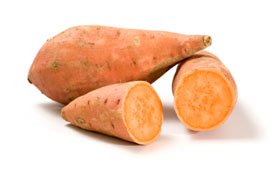Eating with a Conscience
Choosing organic food to protect health and the environment
View a different non-organic crop
 Sweet Potatoes
Sweet Potatoes
Below are the pesticides with established tolerances (residue limits for pesticides used in the U.S. or by countries exporting to the U.S.) for sweet potatoes. While not all the pesticides on the list are applied to all sweet potatoes, there is no way to tell which pesticides are applied to any given piece of conventional produce on your store shelf. You may consider talking to the farmers at your local farmers market about the pesticides they use, but eating organic is the only way to know for sure.
California Farmworker Poisonings, 1992–2010: 0 reported (CA acreage: 13,500). These poisoning incidents only represent the tip of the iceberg because it only reflects reported incidents in one state. It is widely recognized that pesticide incidents are underreported and often misdiagnosed.
Pesticide Tolerances —Health and Environmental Effects: The database shows that while sweet potatoes grown with toxic chemicals show low pesticide residues on the finished commodity, there are 48 pesticides with established tolerance for sweet potatoes, 23 are acutely toxic creating a hazardous environment for farmworkers, 46 are linked to chronic health problems (such as cancer), 17 contaminate streams or groundwater, and 46 are poisonous to wildlife.
![]() Pollinator Impacts: In addition to habitat loss due to the expansion of agricultural and urban areas, the database shows that there are 25 pesticides used on sweet potatoes that are considered toxic to honey bees and other insect pollinators. For more information on how to protect pollinators from pesticides, see Beyond Pesticides' BEE Protective webpage.
Pollinator Impacts: In addition to habitat loss due to the expansion of agricultural and urban areas, the database shows that there are 25 pesticides used on sweet potatoes that are considered toxic to honey bees and other insect pollinators. For more information on how to protect pollinators from pesticides, see Beyond Pesticides' BEE Protective webpage.
- This crop is NOT dependent on pollinators.
- This crop is foraged by pollinators.

(A = acute health effects, C = chronic health effects, SW = surface water contaminant, GW = ground water contaminant, W = wildlife poison, B = bee poison, LT = long-range transport)
|
2,4-D Aldicarb Azoxystrobin Bifenthrin Boscalid Captan Carbaryl Carfentrazone-ethyl Chlorpyrifos Clethodim Clomazone Cypermethrin | Cyprodinil Deltamethrin Diazinon Dicloran (DCNA) Diquat Dibromide Endosulfan EPTC Ethoprop (ethoprophos) Flonicamid Fluazifop-P-butyl Fludioxonil Fluopicolide | Fluridone Glyphosate Imidacloprid Malathion Metalaxyl Methomyl Methyl bromide Methyl parathion Metolachlor Napropamide O-Phenylphenol Phosmet | Phosphine Piperonyl butoxide (PBO) Pyraclostrobin Pyrethrins Pyriproxyfen Sethoxydim Spinetoram Spinosad Thiabendazole Thiamethoxam Trifloxystrobin Trifluralin |
All tolerance data is based on the Environmental Protection Agency's Tolerances and Exemptions for Pesticide Chemical Residues in Food located in the Electronic Code of Federal Regulations (eCFR). For more information, see our Methodology page.








